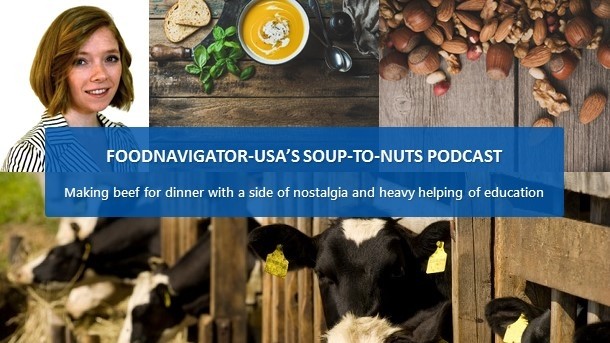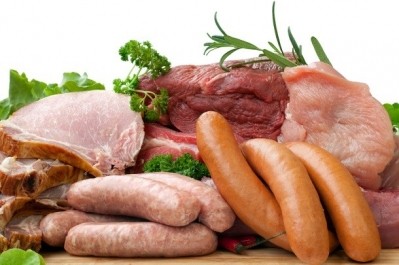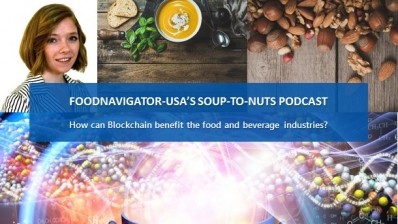Soup-to-Nuts Podcast: Making beef for dinner with a side of nostalgia and heavy helping of education
This content item was originally published on www.foodnavigator-usa.com, a William Reed online publication.

According to the US Department of Agriculture, consumption of beef in the US dropped a whopping 15% from 2006 to 2015, while pork consumption fell only 4% and broiler consumption increased 5%. The agency attributes the shift from beef and pork to chicken to tight supplies that triggered a sharp 53% increase in the price of beef during the period to an average of $5.83 per pound compared to much lower increase of only 12% to $1.90 per pound for broilers.
USDA also attributes the shift away from beef and pork to chicken to health concerns related to red meat intake and innovation by the chicken industry that make poultry more convenient, such as the proliferation of skinless, boneless breast and other ready-to-serve offerings.
But beef’s fortunes may be about to change with USDA predicting beef production will increase 11.7% between 2016 and 2025 due to lower feed costs and high demand, which will translate to a projected 3% increase in per capita consumption in the US during the same period.
The beef industry is poised to seize this opportunity and hopes to fuel it further by bringing back an iconic marketing campaign released a quarter of a century ago, but which Alisa Harrison, senior vice president of global marketing and research at the Beef Association, says has plenty of equity among millennials – many of whom fondly remember the campaign’s original ads featuring a rowdy orchestral rendition of music from the Rodeo ballet, voice overs from famous celebrities such as Robert Mitchum and recommendations for fast dinners, such as Szechuan beef.
In this episode of FoodNavigator-USA’s Harrison explains how the campaign is more than a simple rehash of an iconic tagline. Rather, she says, the new campaign will go beyond its predecessor’s one-way advertising on television, radio and in print to create a two-way conversation through a new dynamic website that will bring together information that nutritionists, retailers, food service operators and consumers want, including recipes, health information and the story of how beef goes from pasture to plate.
What it takes to revive a classic ad campaign
“Beef. It’s what’s for dinner. was first launched in 1992 … and one of the reasons it became so iconic was because it was at the very beginning of the Beef Checkoff and there were a lot of dollars available – I mean $80 million – and I think with the Rodeo music they used … as well as some of the celebrity voices the used, really resonated with people and just became something that people repeated: ‘Oh, Beef. It’s what’s for dinner,’” Harrison said.
And even though it has been 25 years since the campaign first launched, research showed that the tagline still held significant equity with millennials, many of whom recalled memories of it growing up and sitting down to dinner with their families, Harrison said.
“Even those who don’t remember it or hadn’t heard it, it still resonated very well,” according to research by the association, Harrison said – and that became the backbone for bringing it back.
But this time, the campaign will be much more than a tagline and memorable music. Rather, the association hopes to weave the nostalgia of the original campaign through a modern day multifaceted website that will have a little bit for everyone.
The website includes videos, charts and recipes explaining different cuts of beef and how to prepare them – a major hurdle for millennials that stopped them from purchasing it more often, according to Harrison.
It also targets millennials with videos that show how beef is produced on the farm – including some parts that consumers might not want to think about, but the association shares for the sake of transparency, Harrison said.
It also includes detailed nutritional information that tackles head on consumers’ health concerns about eating red meat, and provides guidance to shoppers and dietitians about how to make beef part of a healthy diet.
Key data from industry and retailers also is available, including production and supply data.
Making each dollar count
Previously this information was spread across eight websites – a move that diluted the brand and the value of marketing dollars at a time when there was less money to spend on advertising, Harrison said.
She explained that unlike when the first campaign launched and the association had $80 million at its disposal, this time it only had $30 million, which Harrison noted was “still a great budget,” but which meant each dollar needed to do more.
Luckily, there are more ways to reach consumers now than 25 years ago, with the Internet, social media, influencer campaigns and other digital access points that are less expensive than TV and radio, she said.
The smaller budget was another reason why the association brought back the iconic tagline, because of its existing equity and the fact that the campaign would not need to start from scratch, Harrison added.
Beyond the campaign, Harrison says beef has a promising future based on where it is at in the production cycle and an expectation that, as USDA also notes, more product will become available in the near future – helping to drive down price.
She also noted that while hamburger, steak and roast will likely continue to be industry stars, the association’s focus on education should help consumers realize there are more choices of beef available at all different price points for different occasions.





















